Research Article
USING EXPLORATORY SEQUENTIAL MIXED METHODS FOR TOURISM DESTINATION SAFETY AND SECURITY ATTRIBUTES
8592
Views & Citations7592
Likes & Shares
This paper examined tourism destination safety and security attributes by using a sequential exploratory mixed method to gain a more holistic approach. The first phase involved a qualitative design using the interview method to explore and interpret the perception of tourism destination safety and security. While the second phase involved a quantitative design using survey method to determine the key attributes of tourism destination safety and security. The article demonstrates an exploratory sequential technique which integrates the qualitative and quantitative data as an alternative approach to achieve comprehensive findings as compared to a mono method. Specifically, it presents qualitative findings which were used to develop the quantitative survey questionnaires and confirmation with quantitative findings. The paper enhances the findings through a comprehensive data analysis and integration, thereby facilitating validation of data through cross verification and testing the consistency of findings. The sequential methodology contributes a pragmatic, valid and well-rounded findings in understanding tourism destination safety and security attributes. The article serves as a useful and relevant reference for other researches when using exploratory sequential design for related tourism and hospitality research that are multidimensional in nature or a complex research but lack of baseline data and require confirmation.
Keywords: Exploratory sequential mixed methods, Data integration, Tourism destination, Safety and security attributes.
There has been an increased concern about tourism destination safety and security by the destination management. Simply, key attractions and safety of the tourism destination influenced the potential tourist’s subjective perception with regards to the tourism destination choice (Yang, 2013).
Tourism destination safety and security is shaped by both internal and external factors. The internal factors include the tour operators and tourists while the external factors are societal/cultural, political, environmental, economic and technological.
Due to the fact that tourists are conscious of their tourism destination, it is very crucial that safety and security be emphasized to all concerned at all times (Armenski, 2017). The key attributes, dimension and factors for safety and security at the tourism destination which points out to the safety, security and well-being of the tourists and ensure that the tour operators would enhance the sustainability of the tourism destination. The key attributes to tourism destination would influence tourists to make their decision whether or not to visit the tourism destination as image and perception of the tourism destination would have an impact on their decision. Thus, a safe and secure tourism destination image will emerge as a determining factor to ensure that potential tourists would want to visit the tourism destination of their choice. If the tourism destination is safe and secure, the positive image would appear in the tourists’ mind and then would ultimately encourage or influence them to visit and perhaps revisit the tourism destination. It is beyond the tourism industry’s role to avoid the negativities and consequences arising from safety and security issues. Some of the threats, disasters and crises not only exist globally but regionally as well. These insecurities therefore necessitate this paper to explore the key attributes, dimension and factors. It is important to explore the attributes of safety and security for the tourism industry as a series of tourism threats, disasters and crises strongly impact the tourism industry (Prideaux, 2008).
Malaysia has always been portrayed and promoted as a “safe, peaceful and a hospitality-filled tourist destination” (Som, 2015). However, the issues on safety and security that happened in the eastern coasts of Sabah (kidnappings and the intrusion in Lahad Datu), the two Malaysian Airlines Air Disasters; (MH370 flight from Kuala Lumpur to Beijing, missing without a trace until now since 8th March 2014 where 239 people died) and the (downing of MH17 on 17th July 2014 where 283 passengers and 15 crew perished; flight was from Amsterdam to Kuala Lumpur and shot down while flying over eastern Ukraine), which involved international tourists have raised the question of safety and security in travelling to Malaysia, in particular Sabah, and thus evokes “how safe” is our travelling? (Som, 2015). Travelling by air is the norm to visit any districts in Sabah as the tourism destination are scattered all over the State. This is pertinent as travelling by road is cumbersome and takes time, hence tourists, particularly the international tourists, would rather take a flight than to go on a road tour.
Apart from that, (Lean & Smyth, 2014; Anuar, 2011; Amir, 2012; Yang, 2013). Stated that although the risk encountered within the tourism industry in Malaysia was highlighted and taken note of, it is absurd that there was little concern to conduct related studies in this country. In addition, the focus was on tourists’ risk perception in urban tourism destination only, like in Bukit Bintang, Kuala Lumpur and Johor Bharu but not on the key attributes on tourism destination safety and security (Yang, 2013).
These statements and evidences indicate the need to understand the safety and security measures in a holistic approach to ensure Sabah remain a safe and secure tourism destination. Holistic in terms of the respondents’ involvement and the methods used which consisted of multi-data sources. In defining the holistic approach within the researcher’s context, the nature of the study is confined to Sabah only. The respondents know best in terms of understanding safety and security at the tourism destination unlike other studies which focused on the tourists (one category of respondent) only, thus not providing the holistic findings. Yang, 2013 added that noticeably, the issues pertaining to tourism destination safety and security has been a determining factor that could dampen the tourism industry in years to come as crisis could happen in a domino effect to the tourists. As a result, there is a need to shift the paradigm in dealing with the tourism destination safety and security especially in ensuring that the tourism destination remain safe and more secured.
Sabah is one of the thirteen States in Malaysia and is located on the northern-most part of Borneo, the third largest island in the world. Sabah is surrounded by three different countries - Brunei, Indonesia and the Philippines. Sabah’s coastline is surrounded by the South China Sea in the West, the Sulu Sea in the Northeast and Celebes Sea in the East. Sabah has been battling with safety and security issues such as kidnappings and shootings since 1998, resulting in the decline of tourists to Sabah (Yang, 2013). The most recent kidnapping incident involved three Indonesian fishermen kidnapped in waters off Tambisan Island, Kinabatangan on September 23, 2019 held by the Abu Sayyaf Group Daily Express, 2019. Consequently, the tourism destination in these areas were affected and damaged as not only revenues were lost, but the tour operators and local communities suffered from lack of income generated from the tourists. Arising from unsafe and insecure incidents leading to cancellations of planned journeys or excursion, hence the obvious decrease in revenue for the tourism industry (Rose, 2010).
In view of the above, understanding what factors influence the tourism destination safety and security is of utmost importance and crucial as it will affect tourist arrivals, tourism businesses and dampen positive images of the tourism destination. Past studies of tourism destination safety and security in Malaysia, in particular, Sabah, were very fragmented and had not been discussed thoroughly. For example, factors such as economies, culture, environmental and scenario of politics as its main motivators were not thoroughly discussed. Studies are limited, as stated by (Som, 2015; Woosnam, 2015; Chan, 2014; Ayob, 2014; Konar, 2014; Saha, 2013; Edgell, 2013;Yang, 2013; Kovari, 2011; Cohen, 2012; Popescu, 2011; Aschauer, 2010; Cavlek, 2002; Pizam, 1999; Augustyn, 1998; Yang, 2013). Further stated that although previous researches on issues of safety and security were carried out, the focus was on the perspective of rural tourism destination. There were no holistic understanding and little empirical evidences on the tourism destination safety and security attributes, especially on Sabah. Furthermore, projecting a safe and secure tourists’ destination is vital for Sabah in order to continuously attract tourists; as the tourism industry is an important economic activity for Sabah, ranking as the highest-ever tourism receipts in 2018 (Post, 2019).
RESEARCH OBJECTIVES
In order to examine the underlying key attributes influencing factors of the tourism destination’s safety and security issues, the research objectives aimed to:
- To explore the perception of Sabah as a safe and secure tourism destination,
- To identify key destination safety and security dimensions, and
To identify main factors affecting the destination safety and security by using exploratory sequential mixed research method.
AN EXPLORATORY SEQUENTIAL MIXED RESEARCH METHODS
Understanding the tourism destination safety and security consists of two dimensions namely the human dimension and the tourism destination attributes. This is in tandem with each other as there had been an increase in unsafe and insecure incidents in numerous tourism destinations, for example, the tragic event of September 11, 2001 (Breda & Costa, 2006). Terrorist attacks killing innocent people in Boston, Dhaka, Nice, Indonesia, Philippines and Malaysia (Hall, 2004). Human dimensions included the tour operators and tourists which required the knowledge aspects and the feelings of individuals when dealing with safety and security issues at the tourism destination. Thus, it is very complex, subjective and contextual. In this research, an exploratory sequential mixed methods research design was adopted in order to broadly explore and understand tourism destination safety and security attributes. The exploratory sequential mixed methods design is characterized by an initial qualitative phase of data collection and analysis, followed by a phase of quantitative data collection and analysis, with a final phase of integration or linking of data from the two separate strands of data (Berman, 2017).
The research conceptual framework is presented in Figure 1. The understanding of destination safety and security involved the human and destination dimensions. The nature of the research is complex and multidimensional which consists of cognitive and emotive aspects of human as well as destination attributes which consist of internal and external factors.
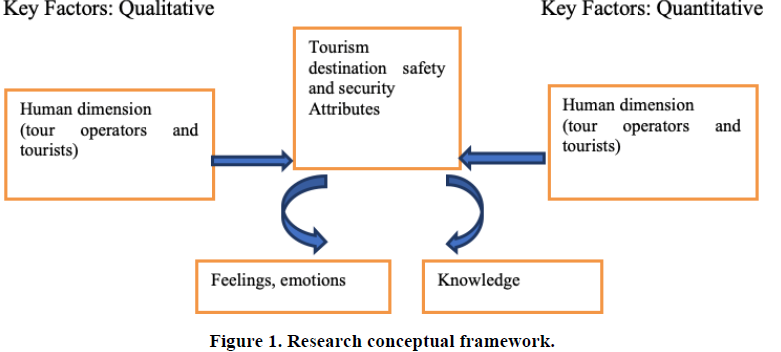
Due to the complexity and subjectivity of the tourism destination safety and security attributes, the paper used a triangulation method in exploring tourism destination safety and security attributes, dimensions and factors. It provided a better understanding of tourism destination safety and security, especially its key attributes, dimensions and factors in a more holistic approach. It explored and examined the underlying key attributes influencing factors of the tourism destination safety and security issues, subsequently its relevance and triangulation arising from the perspective of identified key attributes and factors. The triangulation research method was adopted based on little known phenomena about key attributes, dimensions and factors on tourism destination safety and security issues within the tourism industry in Malaysia, particularly in Sabah. Data from the qualitative and quantitative components were triangulated at the analysis stage as mixed methods systematically became an important approach for data triangulation. It revealed weaknesses in the sampling strategies, methods and analysis to prompt making explicit assumptions and to be precise about limits on generalization (Bryman, 2006). Triangulation is among one of the main objectives of mixed methods research. According to (Denzin, 1978). “Triangulation is the combination of methodologies in the study of the same phenomenon with different methods and to ameliorate internal and external validity” (Creswell, 2009).
As explained by (Creswell, 2009). The sequential exploratory design is “a mixed methods whereby the qualitative data collection and analysis (first phase) is conducted first, followed by the quantitative data collection and analysis (second phase) that builds on the results of the first qualitative phase”. As stated by (Tashakkori & Teddlie, 2003). The main advantage of mixed methods research is the flexibility of answering questions together, thereby the ability to validate and initiate a theory for the research. For this paper, the researcher adopted the sequential exploratory method as data collection as a way of overcoming and substantiating the weaknesses and conforming the strengths of the other method. Figure 2 described the sequential exploratory mixed methods approach.
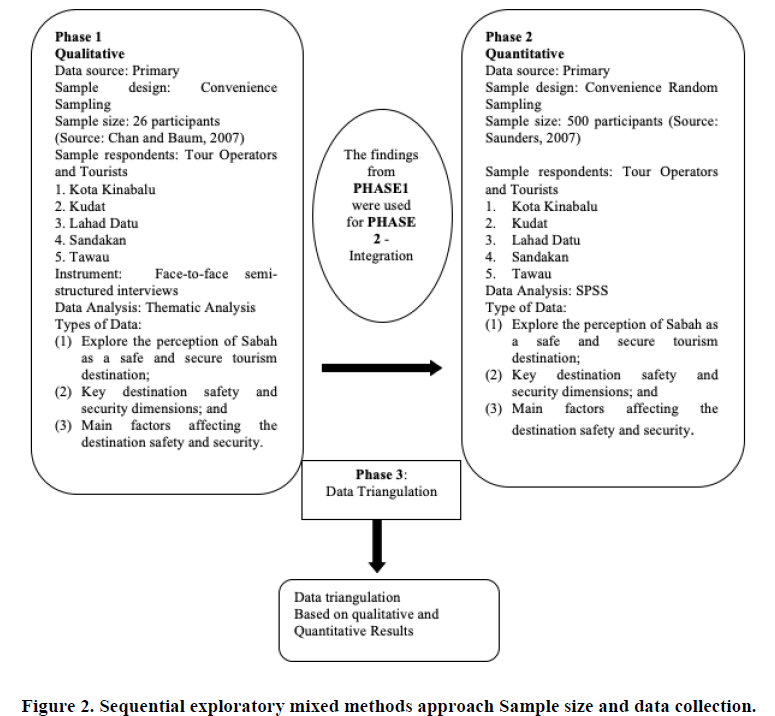
This paper used convenience sampling in choosing people to interview and distribute the questionnaires because of their accessibility. Convenience sampling can sometimes incorporate elements of randomness to increase the potential of convenience samples to be more representative of the research population (Smith, 2010). Data collection involving interviews and distribution with face-to-face survey to gain insights with the respondents were conducted in Kota Kinabalu, Kudat, Lahad Datu, Sandakan and Tawau. The sample respondents consisted of tour operators and tourists.
The qualitative data collection was conducted in January 2017 to March 2017 where 16 tour operators and 10 tourists participated. Subsequently the quantitative data collection took six months and began on the first week of March 2017 and was completed by the end of August 2017 whereby 100 tour operators and 400 tourists participated in the survey. The sample size for interviews and survey questionnaires (Table 1).
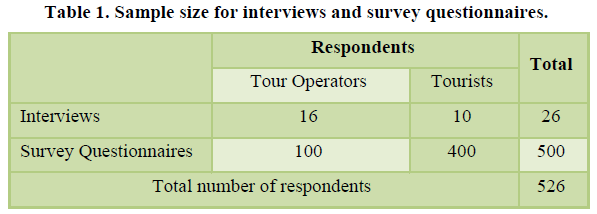
DATA ANALYSIS
Data analysis was based on a single phrase or several significant statements, grounded in the respondents’ own description to enhance the reliability and validity of the findings. A data source triangulation was carried out utilizing interviews and questionnaires. (Packer, 2008) claimed that this approach is a valid option. The paper found out that there were two approaches to lend credence to the study; the first approach was to find out/explore the perception and factors from the respondents while the second approach was the dimensions provided by the respondents. Hence, there was a need to combine both these analyzing methods to compare this research with that of the existing literatures.
A mixed methods data analysis approach was applied in this paper. Data was analyzed using the qualitative approach (interview) while for the quantitative approach, data was analyzed by using Statistical Package of the Social Science (SPSS). The purpose of this form of research was that for both qualitative and quantitative researches, in combination with each other, provided a holistic and practical understanding of a research problem or issue than either research approach alone. The triangulation of this approach compensates for each other’s strength and weaknesses (Creswell, Morell, & Tan, 2009; Rugg & Petre, 2007).
The qualitative findings were used to examine the three research objectives related to exploring tourism destination safety and security which were the perception, dimensions and factors undertaken by the tour operators and tourists. The quantitative data confirmed the key factors revealed by the qualitative findings.
Qualitative data was then used to complement, supplement and conformed the limitation imposed on quantitative findings (Tashakkori & Teddlie, 2010). Both data helped to examine the research questions through perception, dimensions and factors and were chosen to review empirical evidences. The discussion ultimately brought the salient points together in the research. The data triangulation confirmed the coherence of the qualitative and quantitative findings. The assessment of fit of triangulation led to the outcomes. Confirmation occurred when the findings from both types of data confirmed the results of the other. As the two data sources provide similar conclusions, hence, the results have greater credibility (Creswell, 2011).
DATA INTEGRATION PROCESS
Data from the qualitative and quantitative components was integrated at the analysis stage as mixed methods systematically became important for data triangulation as presented in Figure 3. According to (Denzin, 1978). “Triangulation is the combination of methodologies in the study of the same phenomenon with different methods and to ameliorate internal and external validity” (Creswell, 2009).

Data collection consisted of two phases: data collection process in Phase 1 (Qualitative) were first collected by way of interviews and analyzed. Arising from the findings from the interviews, the research objectives were integrated into the survey questionnaires to determine the significant of the factors. Subsequently, data collection for Phase 2 (Quantitative) was conducted by way of survey questionnaires and the factor analysis was then carried out.
In order to confirm the findings, findings of qualitative data from first phase and quantitative data from second phase were triangulated through narrative approach with the weaving approach which involved writing both qualitative and quantitative findings together on a theme-by-theme basis based on the research objectives. The triangulation of qualitative and quantitative dramatically enhanced the value of mixed methods research (Bryman 2006; Creswell & Clark, 2011). Data collected from both qualitative and quantitative were linked together in line with the research objectives and past studies from the literature reviews. The qualitative data was used to assess the validity of quantitative findings. Quantitative data was also used to help generate the qualitative sample or explain findings from the qualitative data.
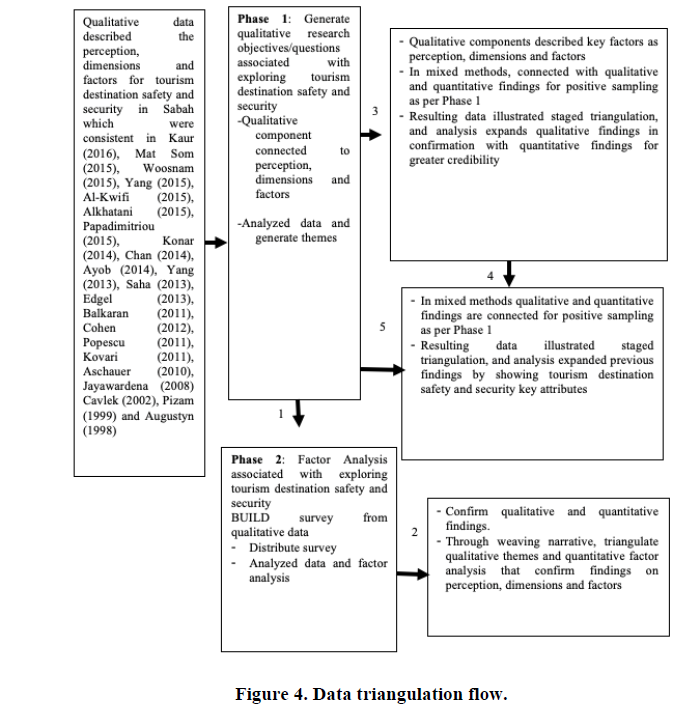
Tour operators were chosen as they provide tour services, organize tours, travel arrangements for their clients/customers and as such, they need to be aware and understand tourism destination safety and security to protect the safety, security and well-being of their clients/customers. Meanwhile, as tourists are conscious of their tourism destination, it is crucial to inculcate the tourism destination’s safety and security. Generally, a safe and secure tourism destination influences the potential tourist’s subjective perception with regards to the tourism destination choice (Yang, 2013). Thus, a safe and secure tourism destination image will emerge as a determining factor to ensure that potential tourists would want to visit the tourism destination of their choice. If the tourism destination is safe and secure, the positive image would appear in the tourists’ mind and then would ultimately encourage or influence them to visit and perhaps revisit the tourism destination.
The qualitative and quantitative findings are as presented in Table 2. Concluded that data triangulation and findings from both qualitative and quantitative were consistent.
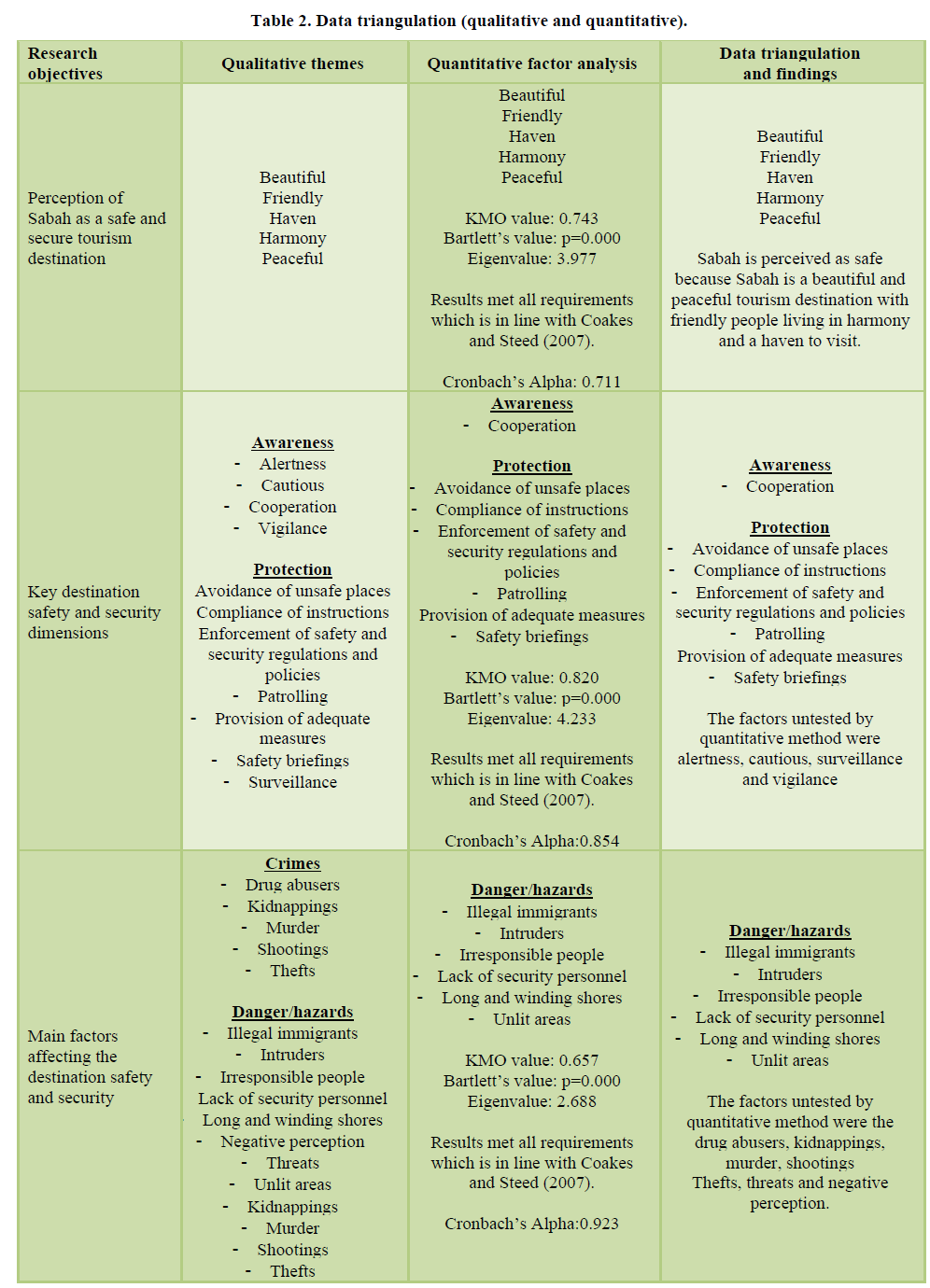
Findings on the perception of Sabah as a safe and secure tourism destination; in the qualitative findings, beautiful, friendly, haven, harmony and peaceful were highlighted and in the quantitative analysis, beautiful, friendly, haven, harmony and peaceful were significant factors through the factor analysis. The two sets of data were considered in describing Sabah as a safe and secure tourism destination. This conclude that Sabah is perceived as a safe tourism destination basically because Sabah, also known as the Land Below the Wind, has a beautiful feature with a wealth of natural paradise to offer to the tourists, having friendly people, as a haven to visit and a peaceful place with harmonious living atmosphere.
Findings on qualitative findings on the key tourism destination safety and security dimensions showed that awareness (such as alertness, cautious, cooperation and vigilance), and added up with protection (such as avoidance of unsafe places, compliance of instruction, enforcement of safety and security regulations and policies, patrolling, provision of adequate measures, safety briefings and surveillance). Meanwhile for the quantitative analysis, it revealed the findings on awareness (such as cooperation) and protection (such as avoidance of unsafe places, compliance of instruction, enforcement of safety and security regulations and policies, patrolling, provision of adequate measures and safety briefings).
Findings on the main factors affecting the tourism destination safety and security; in the qualitative findings, crimes such as drug abusers, kidnappings, murder, shootings and thefts as well as danger/hazards coming from illegal immigrants, intruders, irresponsible people, lack of security personnel, long and winding shores, negative perception, threats, unlit areas, kidnappings, murder, shootings and thefts. While in the quantitative analysis which showed that factors such as danger/hazards namely illegal immigrants, intruders, irresponsible people, lack of security personnel, long and winding shores and unlit areas. Thereby concluding that crimes and danger/hazards were factors that attributed to current safety and security issues. While in the quantitative analysis the findings showed actions (such as cooperation, avoidance of trouble spots, own security personnel, patrolling, safety and security briefings, presence of security personnel and vigilance), measures (such as detection, education and training, education on safety and security, enforcement of safety and security measures and surveillance). This concluded that both approaches (qualitative and quantitative) supported actions and measures as an important suggestion for the relevant authorities to formulate.
CONCLUSION AND LIMITATION
Based on the research findings, this paper provides an insightful understanding of tourism destination safety and security attributes. The research objective on perception of Sabah as a safe and secure tourism destination concludes that Sabah is perceived as a safe and secure tourism destination. Sabah is beautiful tourism destination, with friendly people, a haven to visit, harmonious and peaceful environment were highlighted. The identified key destination safety and security dimensions for research objective two were actions (alertness, awareness, avoidance of unsafe places, cautious), rules and regulations (compliance of instructions, cooperation, enforcement of safety and security regulations and policies, patrolling, vigilance), equipment (provision of adequate measures, surveillance) and training (safety briefings). On research objective three, the main factors affecting the destination safety and security were drug abusers, kidnappings, murder, shootings and thefts as well as danger/hazards coming from illegal immigrants, intruders, irresponsible people, lack of security personnel, long and winding shores, negative perception, threats, unlit areas, kidnappings, murder, shootings and thefts indicating that crimes and danger/hazards were factors that attributed to current safety and security issues.
Due to the complexity and subjectivity of the tourism destination safety and security that involved human and destination dimensions, the paper used a sequential exploratory mixed method as a more holistic and valid approach to explore the safety and security attributes as compared to a single method. It explored and examined the underlying key attributes influencing factors of the tourism destination safety and security issues through qualitative and quantitative approach; where the qualitative data were integrated into the quantitative survey questionnaires. The findings of both qualitative and quantitative data were triangulated to achieve sound findings on tourism destination safety and security attributes. The paper explained and demonstrated the process of undertaking sequential exploratory mixed methodology undertaken in this study. It shared the process of integration and triangulation of data. This article contributes to the existing literature, with the desire of encouraging researchers to continue to undertake studies associated with mixed methodology. It also adds to existing research, informing those undertaking future research the value associated with using the mixed methods approach. Clearly, the depth of understanding from the qualitative data determined the key factors from the quantitative approach, arising from interpretation and the objective paradigm which offered pragmatism which implied that the findings offered a more holistic and well-rounded key factors. Triangulation facilitated the validation of data through cross verification from more than one source and tested the consistency of findings, resulting in a more holistic understanding of tourism destination safety and security. The implications of using the sequential mixed methods was that the approach enhanced the analysis and the interpretation of the findings as data were drawn from mixed methods and it broaden the insight into the different issues underlying the phenomena being studied.
There were a few limitations in this study that may offer opportunity for future research. The limitation of this study could serve as a research gap for future research. Firstly, the scope of this study was focused on tour operators and tourists which embodies the characteristics of specific factors (perception, dimensions and factors) for tourism destination safety and security and have limited generalization. The generalization of findings can be enhanced by expanding the scope of study with samples from other tourism industry’s stakeholders. Secondly, the study site covered specific areas only; in Kota Kinabalu, Kudat, Lahad Datu, Sandakan and Tawau. Reading and densely coding the interview responses was laborious and sometimes mind-numbing, but the findings were interesting and the use of the data for qualitative research was an area that was ripe for meaningful research on public opinions and interpersonal interaction. Lastly, from the research findings, it would be a good move to add other emerging issues related to tourism destination safety and security. Lastly, as this research utilized the mixed methods approach via triangulation, further testing by developing hypotheses in quantitative research can be used to generate theoretical concept to enhance the key factors in this research.
REFERENCES
AlKahtani, S.J.H., Xia, J.C., Veenendaaland, B., Caulfield, C. & Hughes, M. (2015). Building a conceptual framework for determining individual differences of accessibility to tourist attractions. Tourism Management Perspective 16, 28-42.
Al-Kwifi, O.S. (2015). The impact of destination images on tourist’s decision making a technological exploratory study using FMRI. Journal of Hospitality and Tourism Technology 6(2), 174-194.
Armenski, T., Dwyer, L. & Pavlukovic, V. (2017). Destination competitiveness public and private sector tourism management in Serbia. Journal of Travel Research 1, 1-15
Aschauer, W. (2010). Perceptions of tourists at risky destinations a model of psychological influence factors. Tourism Review 65(2), 4-20.
Augustyn, M.M. (1998). The road to quality enhancement in tourism. International Journal of Contemporary Hospitality 10(4), 145.
Ayob, N.M. & Masron, T. (2014). Issues of safety and security: New challenges to Malaysia tourism industry. SHS Web of Conferences 12, 01083.
Baloglu, S. & McCleary, K.W. (1999). A model of destination image formation. Annals of Tourism Research 26(4), 868-897.
Balkaran, R. & Maharaj, S. (2013). The application of the theory of visitor attractions and its impact on the competitive advantage of the tourism sector in Durban, South Africa. Journal of Economics and Behavioural Studies 5(8), 546-552.
Berman, E.A. (2017). An exploratory sequential mixed methods approach to understanding researchers data management practices at uvm integrated findings to develop research data services. Journal of eScience Librarianship 6(1).
Post, B. (2019). Record RM8.3bln from Sabah Tourism in 2018. 20 February.
Breda, Z. & Costa, C. (2006). Safety and security issues affecting inbound tourism in PRC in Y Mansfeld A Pizam (Eds) Tourism Security and Safety from Theory to Practice. Elsevier Butterworth-Heinemann.
Bryman, A. (2006). Integrating quantitative and qualitative research how is it done qualitative inquiry. 6(1), 97-113.
Cavlek, N. (2002). Tour operators and destination safety. Annals of Tourism Research 29(2), 478-496.
Chan, J.K.L. (2014). Understanding coastal seaside resorts in Sabah its growth factors key attributes and operational strategies. Tourism Leisure and Global Change 1, 1-12.
Paper presented at the 6th Tourism Outlook Conference (2013). 22-24 April 2013 Kota Kinabalu Sabah, Malaysia.
Cohen, E. & Cohen, S.A. (2012). Current Sociological Theories and Issues in Tourism. Annals of Tourism Research 39(4), 2177-2202.
Creswell, J.W. & Tashakkori, A. (2007). Editorial developing publishable mixed methods manuscripts. Journal of Mixed Methods Research 1(107), 106-111.
Creswell, J.W. (2009). Research design qualitative and mixed methods approach. Thousand Oaks California Sage Publications.
Creswell, J.W. & Clark, P.V.L. (2011). Designing and conducting mixed methods research. Thousand Oaks California Sage Publications.
Denzin, N.K. & Lincoln, Y.S. (2003). The Discipline and Practice of Qualitative Research Collecting and Intepreting Qualitative Materials 2ndEdition Sage Publications.
Echtner, C.M., & Ritchie, J.R.B. (1993). The measurement of destination image an empirical assessment. Journal of Travel Research.
Edgell, D. & Swanson, J. (2013). Tourism Policy and Planning Yesterday today and tomorrow New York Routledge.
Fetters, M.D. & Freshwater, D. (2015). The 1 + 1 = 3 Integration Challenge. Journal of Mixed Methods Research 9(2), 115-117.
Fetters, M.D. (2018). Six equations to help conceptualize the field of mixed methods. Journal of Mixed Methods Research 12(3), 262-267.
Hall, C.M., Timothy, D.J. & Duval, D.T. (2004). Security and tourism towards a new understanding. Journal of Travel and Tourism Marketing 15(2-3), 1-18.
Jayawardena, C., Patterson, D.J., Choi, C. & Brain, R. (2008). Sustainable tourism development in niagara discussions theories projects and insights. International Journal of Contemporary Hospitality Management 20(3), 258-277.
JohnRose, J. (2010). Safety and security in the tourism industry: A regional perspective on tourism security. Caribbean Tourism Organization.
Johnson, R.B., Onwuegbuzie, A.J. & Turner, L.A. (2007). Toward a definition of mixed methods research. Journal of Mixed Methods Research 1(2), 112-133.
Kaur, A., Chauhan, A. & Medury, Y. (2016). Destination image of Indian tourism destinations. Asia Pacific Journal of Marketing and Logistics 28(3), 499-524.
Kovari, I. & Zimanyi, K. (2011). Safety and security in the age of global tourism the changing role and conception of safety and security in tourism. Applied Studies in Agribusiness and Commerce 5(3-4), 59-61.
Lean, H.H., Chong, S.H. & Hooy, C.W. (2014). Tourism and economic growth comparing malaysia and singapore. International Journal of Economics and Management 8(1), 139-157.
Som, A.P.M., Ooi, C.A. & AlBattat, A.R. (2015). Tourists perception of crisis and the impact of instability on destination safety in Sabah Malaysia. Journal of Tourism and Environment Social and Management Sciences 96-103.
Morell, L. & Tan, R.J.B. (2009). Validiting for use and interpretation: A mixed methods contribution illustrated. Journal of Mixed Methods 3(3), 242-264.
Ogle, A.W. (2015). Tourism security strategies for effectively managing travel risk and safety. International Journal of Akdeniz University Tourism Faculty 3(2), 138-140.
Papadimitriou, D., Apostolopoulou, A. & Kaplanidou, K. (2015). Destination personality affective image and behavioral intentions in domestic urban tourism. Journal of Travel Research 54(3), 302-315.
Popescu, L. (2011). Safety and security in tourism case study Romania. Forum Geografic 10(2), 322-328.
Rugg, G. & Petre, M. (2007). A gentle guide to research methods. Open University Press McGraw-Hill United Kingdom.
Sharp, J.L., Mobley, C., Hammond, C., Drew, S., Stringfield, S., & Stipanovic, N. (2012). A Mixed Method Sampling Methodology for a Multisite Case Study. Journal of Mixed Methods Research 6(1), 34-54.
Tashakkori, A. & Teddlie, C. (2010). Sage handbook of mixed methods in social and behavioral research thousand oaks. Sage Publications.
Williams, A.M. & Balaz, V. (2015).Tourism risk and uncertaint theoretical reflections. Journal of Travel Research 54(3), 271 -287.
Woosnam, K.M., Shafer, C.S., Scott, D., & Timothy, D.J. (2015). Tourists perceived safety through emotional solidarity with residents in two mexico-united states border regions. Journal of Tourism Management 46, 263-273.
Yang, C.L. & Nair, V. (2013). Tourism safety security and risk towards a conceptual framework. Proceedings of the 3rd regional conference on tourism research 29-31 October Langkaw Malaysia.
Yang, C.L., Sharif, S.P. & Lattimore, C.K. (2015).Tourists risk perception of risky destinations the case of Sabahs eastern coast. Tourism and Hospitality Research 1-16.






